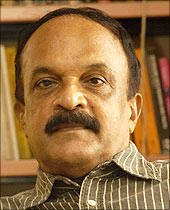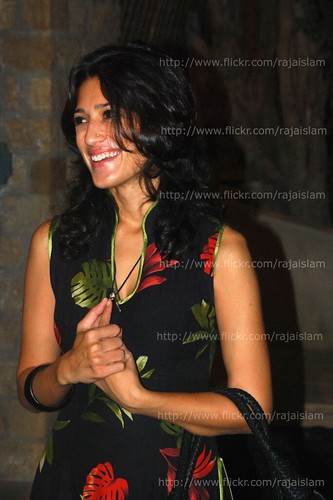October 1, 2011
It is the Kovalam literary festival weekend in the city. Benazir Bhutto's cousin, Fatima, a writer, landed in town yesterday and was a instant hit with the media. Kurien Issac Sir suggested that we meet at Kanankunnu Palace, the venue of the literary fest this morning. It is natural to wonder why the 'Kovalam' literary festival finds itself inaugurated at Kanakakunnu Palace. I don't think the name Kovalam in the literary festival has anything to do with the location expect that an internationally recognized beach name can't do any harm when sending out invites. At one point, we speculated that the name might have to do with Kovalam Kavikal, but no. The fest grew out of the annual lectures organized in memory of Binoo K John's father who was also a journalist. Binoo K John, the organizer, is a recognized author in Indian English literature.
I was at the venue by 10am.The lecture hall was three quarters packed. Cellphones were constantly ringing. The cacophony of ringtones is the new Indian national anthem freely remixed whenever crowds gather. Couple of policemen on duty were also taking on their mobiles. But they had the courtsey to do so outside the hall. Few desks with neatly arranged stacks of new books and bestsellers for sale. I found a seat under the last ceiling fan.
Right before the ceremony was to begin a young man came and sat next to me. He leaned over and asked, "Arun alle?" (Arun, right?). I nodded and confessed that I did not recognize him. It is a painful fact that facebook profile pictures tend to do precious little when it comes to real world facial recognition. Once he identified himself, my memory cranked up past imaginings from St. Thomas School. He studied a junior to me. He happens to be the nephew of Binoo K John and had come down from Bangalore for a couple of days to help with the festival. It was great to meet an old face from school, even better to see one involved in a literary fest.
The event kicked off. The emcee was a disappointment. She spoke in the uber-official, obsequious Indian English. She talked about the "emperors, kings, queens, princess and princes" of literature who were present. Given that we were in a palace, I was hopeful. But despite straining my neck, no crowns, tiaras or royal staffs were to be seen. She "humbly requested" in this "most auspicious moment" the "honorable respected chief guest" to light the lamp "kindly". Then rather unkindly she made Miss Bhutto a Mrs and for the rest of event kept on murdering and bringing back to life that imaginary husband she had assigned the chief guest.
The welcome speech was by renouned Malayalam writer Zachariah. He summed by saying Thiruvananthapuram is "more or less a beautiful city with some dirt on the side" and "it is more or less a peaceful, tranquil city". Then he made an amazing statement. While looking at Fatima Bhutto who had been smiling through the whole speech, he bobbed his head and said, "so this is that is!". She bobbed her head in response. I guess "so this is that is" is something from the Upanishads along the lines of "Thou art that" (Tat-twam-asi). Happy to learn that the head bobbing crosses the Line of Control.
An award was given to Rakesh Nath for being a promising young writer in the festival's eyes. He obliged the emcee's 'humble request' to 'kindly share a few words' and began reading off of a paper addressing non-existent "other dignitaries" on the stage. English was not his forte. He said something about string theory and 10 raised to 500 universes. His book '0+0=big bang' was the reason for the award. It was in Malayalam and he read an excerpt. As soon as he switched to his mother-tongue, he transformed into a master of words. I'll check that book out soon.
Fatima Bhutto's writing skills must be better than her oratory skills. Not that it was a boring lecture. She spoke about the shared history of the Indus Valley civilization, making a few flowery comments on the art from that culture which showed her strength in fiction and fertile imagination but also would have made any archeologist or art historian squirm. Since I am neither, I simply shifted on my seat. She inserted a few jokes. She was spontaneous at a couple of places. She tried to engage the audience in an attempt to localise her theme of Indo-Pak harmony. But the audience were busy filming her on their cellphone or just wondering what brand of Fair & Lovely cream she uses.
Half way through her lecture, I saw Issac sir walk in. He took a seat to the my right and promptly texted me that he was there. I replied specifying the co-ordinates of my location in a hall-centered reference frame measured in chair units. In all this SMS business, I lost the final thrust of Ms. Bhutto's lecture if there was one. I am sure there was some good points well made because there was considerable applause when she finished. From the first half hour of the lecture that I listened to, she is a reluctant Arundhati Roy. I think the reluctance has something to do with the consequences she might face in Pakistan.
We made Navara rice for lunch today. With rasam, bitter gourd curry and sambharam (buttermilk with curry leaves and onions), it was a feel good, healthy meal. Cooked navara rice reminds the tongue of adzuki beans, in texture and flavor. But at Rs 99/- for 250g, it'll remain a "medicinal" food.
Talking of medicinal foods, the coconut flower (thengin pookkula) led palpable tension in the family atmosphere this morning. Amma was not too keen on cooking it because she believed it is meant only for post-natal care of women and would induce bleeding.
Achan pooh-poohed this notion!
Amma tried to gather support from Rema aunty and Omana.
"Saarinum Unnikum kodukale!"(Don't give Achan and me), Omana's ominous warning.
Achan asked for their nutritionist and medical degrees.
Then he wondered aloud why anyone would put the recipe on the internet if it was going to be damaging.
Ahem! I kept quiet and went along with his argument that internet is the "authority" on reliable, constructive information. I desparately wanted to taste the dessert.
Achan reminded Amma that Omana had recently said that all snakes are male and all rat snakes are female.
This was the clincher.
Amma made the dessert but she left the heavy duty stirring to Achan.
I guess that is all the spooning he is going to have for quiet a while. The dish is divinely delicious.
In the afternoon, Amma and Rema Aunty went to see Mohanlal's 300th film, Snehaveedu (love home) which was released yesterday. "Kandilennu vachu nashtamonnumila" (No loss even if you don't see it), Amma's concise review when she returned.
Yet another dramatic evening. Theater of Good Hope (that apparently has none religious affiliation that its name seems to invoke) was presenting the Malayalam translation of the Kannada play called Sidhathae by the famous writer, Lankesh. It was being staged at the Vyloppilli Samskriti Bhavan. This was my first visit to that center. What a spectacular venue! Built mostly with wood and stone and roofed with baked clay tiles, it is the most traditional playhouse I have ever been to. A raised stage inside the hall is itself shaped like a "koothambalam". With hanging brass lamps supplying the hall lighting, it is the perfect stage for any classical music and dance performance. And today, I saw that it can be set up very well for drama lights and sound as well.
The same campus has the Kerala Historical Research Council, Bharath Bhavan, State Archives and Lalita Kala Academy. Besides the main hall and stage, there are two open air 'mandapams' in granite and wood set up for performances. And an impressive amphitheater!
The drama was rather short. Only 45 minutes, much to the disappoint of my youngest uncle who showed up 20 minutes late. There was a sizeable audience...around 250. The drama dealt with the final outburst of an artist who had compromised his entire life for work and for family. Sulfikar who acted as the rebel son was brilliant. I think he has a bright future in television and cinema. The dark humor was brilliant in parts. Lines like "Why Iyer? Why an Iyer? Because an Iyer is always a little higher!" drew chuckles from the crowd.
I don't know if the original play also opens with the song, "Mere Saajan hai us paar" composed and sung by SD Burman from the Bimal Roy movie, Bandini. Such a beautiful song to start a play about unfulfilled dreams.
http://www.youtube.com/watch?v=8rxJWLtWCfM





Love ur blog.....jus a small disagreement abt this post.....abt the vylopilli smarakam...it's not all wood and stone....nor is it traditional kerala architecture....it's a modern steel and concrete building dressed up as traditional Kerala building...there's a beautiful steel truss hidden in tht tiled roof....the seemingly stone pillars are actually concrete pretending to be stone....insulting to both concrete and stone
ReplyDeleteThanks for pointing that out :-)
ReplyDelete